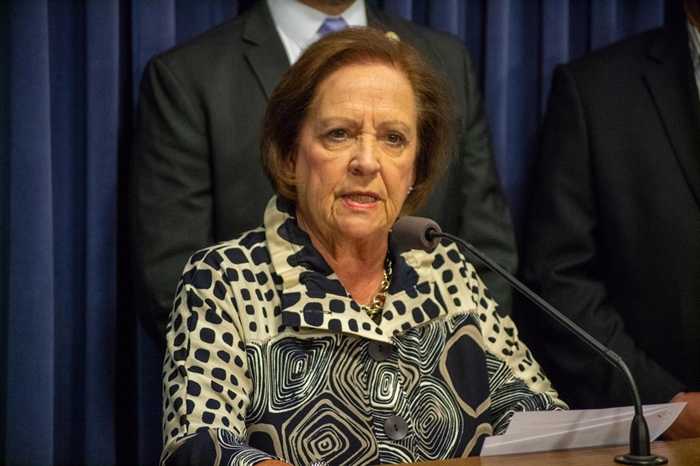Nearly $1B in expected spending on health care in Illinois for noncitizens adds to state budget pressures

SPRINGFIELD – The state estimates an expansion of state-sponsored health care to individuals who are ineligible for Medicaid based on their citizenship status is expected to cost $990 million in the upcoming fiscal year, far outpacing the original price tag cited when the measures became law.
In 2020, Illinois made noncitizens aged 65 and older eligible for Medicaid-type coverage, becoming the first state to do so. The Health Benefits for Immigrant Seniors program is open to individuals whose income is below the federal poverty level.
It’s a cost born entirely by the state because the individuals are not eligible for the Medicaid program that is split roughly 50-50 between the state and the federal government.
The expansion was inserted into a late draft of what’s known as the budget implementation bill in the pandemic-shortened 2020 session. It was an initiative of the Illinois Legislative Latino Caucus and sponsored in the House by Rep. Delia Ramirez, D-Chicago, who has since moved on to the U.S. Congress.
She and other advocates said providing health care, especially preventative care, to immigrant populations would be cheaper than making them dependent on emergency room visits.
“You can pay taxes, you can do this, you can do that, you can be in this country for 25 years attempting to legalize, but you can’t get this basic health care, basic ability to stay alive, covered. If ever before, this pandemic has shown us how critical that is,” Ramirez was quoted in the Springfield State Journal-Register at the time.
Ramirez pegged the program’s Fiscal Year 2021 cost at $2 million, according to the newspaper.
The source of the initial estimate is unclear, although Gov. JB Pritzker’s administration said it had not prepared its own estimate before the program became law because it was a lawmaker-driven initiative. Republicans noted at a Thursday news conference that it was not thoroughly vetted in committee before being added to the budget.
The actual cost of the program far exceeded that estimate, and the program exceeded its FY 2021 appropriation within the first month of implementation, according to a closed-door presentation by the Illinois Department of Healthcare and Family Services to lawmakers last month.
The cost of care for the 65 and over age group was nearly $188 million between March 2022 and February 2023, per that presentation.
Since the program’s initial passage, lawmakers have expanded it twice, lowering the age limit to 55 in 2021 and 42 a year later. The expanded program is known as Health Benefits for Immigrant Adults.
Outpacing estimates
As the expansion was to be implemented in 2021, IDHFS brought in its own consultant to try to get a clearer picture of what it would cost. For the current fiscal year that concludes June 30, the actuarial firm Milliman estimated the total program costs would be about $222 million.
But the actual cost for all three age groups was $410 million from March 2022 through February 2023, according to the department.
Milliman’s estimates used American Community Survey data and “assumed…enrollees would not cost more than Medicaid enrollees,” the department noted in its presentation. But IDHFS noted actual program spending “reflects higher enrollee costs than the traditional Medicaid population due to more untreated chronic conditions and higher hospital costs.”
While the presentation laid out higher-than-expected costs for the program, it also noted per-enrollee costs for those age 65 and older are stabilizing because enrolled individuals are getting chronic conditions under control. For all groups, initial costs were higher due to the number of long-untreated conditions now receiving care.
Milliman also underestimated the number of enrollees in the immigrant community, a notoriously difficult population to track. Its estimate of 33,500 total enrollees was exceeded by more than 18,000 with four months to go in Fiscal Year 2023. The number is expected to grow to nearly 99,000 next fiscal year as enrollees in the 42-54 range continue to grow by about 10 percent each month.
When the program’s expansion to the population aged 42-54 passed one year ago, Republicans noted in Senate floor debate that it was tacked onto a bill that had otherwise been agreed to by working group members of both parties.
Milliman’s cost estimate of $68 million for the age 42-54 group was cited in floor debate, but thus far over $104 million in claims has been paid out. That number is expected to grow to $460 million in the upcoming fiscal year for that age group.
All told, the estimated $990 million price tag for the upcoming year represents a $768 million increase over the faulty initial current-year estimate. The Pritzker administration said IDHFS could cover about $300 million of the cost difference within its budget as proposed by the governor, while the rest would be subject to ongoing budget negotiations.
Another Democrat-sponsored bill that remains in committee would add 19-41-year-olds to those covered under the Medicaid-style program. Milliman’s estimate projected that expansion would cost $280 million, but whether it ends up in the final budget remains to be negotiated.
Republicans call for pause
House Republicans called for a “pause” and “audit” on the existing program at a Statehouse news conference Thursday.
“We haven’t seen the full magnitude of what the liability could be for this program,” Rep. Ryan Spain, R-Peoria, said at the news conference. “And you know, this is a large country where people are moving to different areas based on what benefits may be available to them. So we’re just scratching the surface of what could be our future unfunded liability in this area.”
While Republicans have long criticized spending state funds on noncitizens, Democratic backers of the proposals note that individuals pay sales, income and other taxes as Illinois residents, even if they’re not U.S. citizens.
The House GOP on Thursday said the program’s funding could be reallocated to other “drastically underfunded” programs and agencies, such as the Department of Children and Family Services and to cut down on wait lists for people most in need of substantial state care.
“The $990 million could be used to support services to the developmentally disabled…to address the substantial workforce shortages within our nursing homes across the state,” Rep. Norine Hammond, R-Macomb, said.
Sen. Omar Aquino, a Latino Caucus member and Democratic Caucus Chair in the Senate, responded to the GOP criticism saying the larger-than-expected enrollment in the program “only reflects a great need for health care options in underserved communities.”
“As usual, some lawmakers on the other side of the aisle treated the needs of large communities as cold-hearted unfinished statistics to score political points,” Aquino said in a statement.
The Pritzker administration noted the higher-than-expected costs represent just another variable in budget negotiations, and it asserted its fiscal track record of credit upgrades, long-term savings and debt retirement.
“To be clear, the only lawmakers with a proven record of balancing the budget and improving state finances are Gov. Pritzker and the Democratic supermajority in the General Assembly,” Pritzker spokesperson Jordan Abudayyeh said in a statement. “The governor just proposed another balanced budget that invests in education, health care, and communities.”
Other spending pressures
Along with the spending pressures outlined by Hammond Thursday, providers at community facilities serving developmentally disabled individuals are seeking a funding increase beyond what Pritzker has proposed, municipalities are seeking a roughly $250 million increase in state aid for the upcoming fiscal year, and some lawmakers are advocating for a permanent child tax credit.
Various Republicans have called for decreasing or eliminating the estate tax, creating a child care tax credit, making permanent a sales tax exemption for groceries, exempting prescription drugs and medical devices from the state sales tax, doubling a senior income tax exemption and paying energy rebates to downstate utility customers.
The long list of funding requests comes amid a backdrop of surging state revenues. The nonpartisan legislative Commission on Government Forecasting and Accountability in early March increased its revenue projection for the upcoming fiscal year to about $465 beyond what the governor had projected.
But March saw the first year-over-year revenue decline of any month in the current fiscal year, and a recent report from the commission projects slow revenue growth over the next three years among increased spending pressures. April, however, is the most important month for revenue projections, as Illinoisans file their taxes and the scope of available funding becomes more clear. The April revenue update is due in early May.
Pritzker’s office didn’t rule out any new spending measures or further expansion of health care to noncitizens but said the governor and lawmakers “will continue on the proven track of working together to ensure state spending does not exceed revenues.”
Miss Clipping Out Stories to Save for Later?
Click the Purchase Story button below to order a print of this story. We will print it for you on matte photo paper to keep forever.

